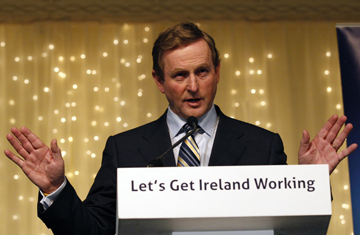
Fine Gael leader Enda Kenny addresses supporters in Dublin on Feb. 26, 2011
Irish people did not revolt or strike when their financially ruined country received what they considered to be a humiliating E.U.-IMF €85 billion ($115 billion) bailout in November. But it seems they were reserving their anger for the ballot box. On Friday, Feb. 25, voters doomed the ruling Fianna Fail Party — blamed for Ireland's economic meltdown — to a crushing defeat and instead handed victory to what will most likely be a coalition between the center-right party Fine Gael and the center-left Labour.
Fine Gael leader Enda Kenny is certain to become the next Prime Minister as his party mops up dozens of seats left behind by high-profile Fianna Fail casualties. Fine Gael has increased its number of seats by 50% to become the largest party in the state, but it failed to get an overall majority and so is in talks now with Labour about forming a coalition.
The center-right Fianna Fail, which had been the biggest party since the founding of the Republic of Ireland, suffered a historic shift in support, losing three-quarters of its seats to become Ireland's third largest party. It's left with just one politician in the capital city, Dublin — down from 17 — and has lost most of its senior members, including the former Deputy Prime Minister. The outgoing government's smaller coalition partner, the Green Party, was also punished, with none of its six politicians voted back in.
Many saw the vote as a referendum against Fianna Fail more than as a vote for Fine Gael. "This was a rejection of the old guard rather than any great enthusiasm for Enda Kenny," says Eoin O'Malley, a political scientist at Dublin City University. Observers point to the fact that many voters picked independent candidates over Fine Gael — the seats filled by independent candidates have almost tripled since the last election.
If Fine Gael and Labour join forces in a coalition, the junior partner — which saw its seats almost double, making it Ireland's second largest party — will probably face a particularly hard time from the opposition benches, where there has been a surge in the hard-left parties. This surge includes a tripling of representation for Sinn Fein, the political wing of the Irish Republican Army (IRA), whose success was led by a win for Gerry Adams, a key figure in the Northern Ireland peace process. But a Fine Gael–Labour coalition would also give the government a huge majority, which could provide the "stable and strong government" that a victorious Kenny told state TV broadcaster RTE on Saturday, Feb. 26, he wants to form "very quickly."
The main sticking points in the negotiations between Labour and Fine Gael will be on how exactly to introduce harsh measures needed to reduce the deficit. "They won't agree on everything but will agree on important issues, like wanting to renegotiate the bailout," O'Malley says. The E.U.-IMF bailout guarantees Kenny a short honeymoon period. Renegotiating the terms of the loan — to ease the pain on Irish taxpayers — will be an immediate priority as he prepares for a crucial March 25 E.U. summit on the banking and debt crisis. "There is going to be an eyeball-to-eyeball showdown between Ireland and Germany," says Brian Lucey, associate professor in finance at Trinity College Dublin, referring to Germany's resistance to letting Ireland renegotiate the bailout. But having a mandate from the electorate and a public rejection of former government policies will be an "important political card," Lucey adds.
So while the election can't solve Ireland's high unemployment, increasing emigration and imminent government cuts overnight, Irish voters find themselves feeling satisfaction at having punished those they blame for the nation's woes and hope for the new faces tasked with rebuilding the country's economy.
